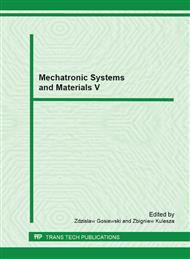[1]
M. Acar, and R.M. Parkin, Engineering Education for Mechatronics, IEEE Trans. on Industrial Electronics, vol. 43, no. 1, pp.106-112, Feb. (1996).
DOI: 10.1109/41.481414
Google Scholar
[2]
R. T. Castles, T. Zephirin, V. K. Lohani, P. Kachroo, Design and Implementation of a Mechatronics Learning Module in a Large First-Semester Engineering Course, IEEE Trans. on Education, vol. 53, no. 3, pp.445-454, Aug. (2010).
DOI: 10.1109/te.2009.2027333
Google Scholar
[3]
G. Ostojic, S. Stankovski, L. Tarjan, I. Senk, and V. Jovanovic, Development and Implementation of Didactic Sets in Mechatronics and Industrial Engineering Courses, Int. J. of Eng. Education, vol. 26, no. 1, Tempus publications, (2010).
DOI: 10.1109/te.2009.2036002
Google Scholar
[4]
D. Bradley, What is Mechatronics and Why Teach It?, Int. J. of Electrical Eng. Education, 41, (2004), pp.275-291, (2004).
Google Scholar
[5]
D. Bradley, Mechatronics - More questions than answers, Mechatronics, vol. 20, no. 8, Special Issue on Theories and Methodologies for Mechatronics Design, pp.827-841, Dec. (2010).
DOI: 10.1016/j.mechatronics.2010.07.011
Google Scholar
[6]
A. Vitko, L. Jurišica, A. Babinec, F. Duchoň, M. Kľúčik, Some Didactic Problems of Teaching Robotics, Proceedings of the 1st International Conference Robotics in Education 2010. Bratislava, 16. -17. 9. 2010, Bratislava, Slovak University of Technology in Bratislava, ISBN 978-80-227-3353-3, pp.27-30, (2010).
Google Scholar
[7]
E. Ostertagová, Computer aided learning at FEI TU Košice. In: Proceeding of Int. Scientific Conf. on Inovation proces in e-learning. Bratislava, march, 10th 2011. pp.1-5. - ISBN 978-80-225-3112-2 (in Slovak).
Google Scholar
[8]
T. J. van Beek, M. S. Erdena, T. Tomiyamaa, Modular design of mechatronic systems with function modeling, Mechatronics, vol. 20, no. 8, pp.850-863, Dec. (2010).
DOI: 10.1016/j.mechatronics.2010.02.002
Google Scholar
[9]
Y. Wang, Y. Yua, Ch. Xiea, H. Wanga, X. Feng, Mechatronics education at CDHAW of Tongji University: Laboratory guidelines, framework, implementations and improvements, Mechatronics, vol. 19, no. 8, p.1346–1352, Dec. (2009).
DOI: 10.1016/j.mechatronics.2009.09.001
Google Scholar
[10]
M. Kelemen, T. Kelemenová, Study model of the snake like robot. In: Recent Advances in Mechatronics 2008-2009. Berlin: Springer-Verlag, 2009 pp.228-232. - ISBN 978-3-642-05021-3.
DOI: 10.1007/978-3-642-05022-0_39
Google Scholar
[11]
M. Vacková, R. Surovec, A. Gmiterko, Using of the basic stamp 2 microcontroller in mechatronics. In: MMaMS 2011: Modelling of Mechanical and Mechatronical Systems: proceedings of the 4th international conference: Herľany, Slovakia, 20. - 22. 9. 2011. SjF TU Košice, 2011, pp.508-513.
Google Scholar
[12]
M. Kelemen, T. Kelemenová and J. Jezný, Four legged robot with feedback control of legs motion. In: Bulletin of Applied Mechanics. Vol. 4, no. 16 (2008), pp.115-118. - ISSN 1801-1217.
Google Scholar
[13]
I. Virgala, M. Vacková, M. Kelemen, Two-legs walking robot Wigril,. In: Medical and treatment. Vol. 40, no. 2 (2010), pp.32-35. - ISSN 0301-5491.
Google Scholar
[14]
Ľ. Miková, M. Kelemen, T. Kelemenová, Four wheeled inspection robot with differential controlling of wheels. In: Acta Mechanica Slovaca. Roč. 12, č. 3-B (2008), s. 548-558. - ISSN 1335-2393.
DOI: 10.21496/ams.2019.016
Google Scholar


